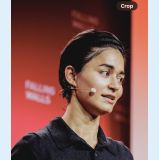
Center for Medical Physics and Biomedical Engineering
Position: Research Associate (Postdoc)
ORCID: 0000-0002-0460-0199
T +43 1 40400 19890
gunpreet.oberoi@meduniwien.ac.at
Keywords
Animal Experimentation; Imaging, Three-Dimensional; Medical 3D-Printing; Neonatology; Patient Simulation; Tissue Engineering
Research interests
Experienced dentist, researcher, and entrepreneur specializing in medical additive manufacturing, patient-specific medical device innovation, and medical device regulation. A significant aspect of Dr. Coudert's work is the creation of life-like simulation models to prepare medical personnel for emergency situations. Dr. Coudert's experience with dental drills and a PhD in 3D printing has enabled her to found the future spin-off SVAN, based on a neonatal emergency drill called SVAN. Dr. Coudert is also a core member of the European special interest group, EU3DSIG, that promotes the implementation of point-of-care in-house 3D printing in compliance with MDR, and leading the fundraising working group.
Techniques, methods & infrastructure
medical 3D printing, animal studies, Clinical studies, medical device regulation, medical device design
Grants
- SVAN- Safe Vascular Access Needle for Birth Emegencies (2023)
Source of Funding: FFG (Austrian Research Promotion Agency), Spin-off Fellowship
Principal Investigator
Selected publications
- Wagner, M., Werther, T., Unger, E., Kasprian, G., Dovjak, G., Dorfer, C., Schned, H., Steinbauer, P., Goeral, K., Olischar, M., Roessler, K., Berger, A., & Oberoi, G. (2021). Development of a 3D printed patient-specific neonatal brain simulation model using multimodality imaging for perioperative management. Pediatric research, 10.1038/s41390-021-01421-w. Advance online publication. https://doi.org/10.1038/s41390-021-01421-w
- Hatamikia, S. et al., 2020. Additively Manufactured Patient-Specific Anthropomorphic Thorax Phantom With Realistic Radiation Attenuation Properties. Frontiers in Bioengineering and Biotechnology, 8. Available at: http://dx.doi.org/10.3389/fbioe.2020.00385.
- Oberoi G, Kornfellner E, Aigner DA, Unger E, Schwentenwein M, Bomze D, Staudigl C, Pahr D, Moscato F. Design and optimization of a novel patient-specific subperiosteal implant additively manufactured in yttria-stabilized zirconia. Dent Mater. 2024 Oct;40(10):1568-1574. doi: 10.1016/j.dental.2024.07.008. Epub 2024 Jul 30. PMID: 39084954.
- Hatamikia, S. et al. (2022) ‘Additively manufactured test phantoms for mimicking soft tissue radiation attenuation in CBCT using Polyjet technology’, Zeitschrift für Medizinische Physik [Preprint]. Available at: http://dx.doi.org/10.1016/j.zemedi.2022.05.002.
- Oberoi, G. et al., 2020. Titanium dioxide-based scanning powder can modulate cell activity of oral soft tissue - Insights from in vitro studies with L929 cells and periodontal fibroblasts. Journal of Prosthodontic Research, 64(1), pp.34–42. Available at: http://dx.doi.org/10.1016/j.jpor.2019.05.001.